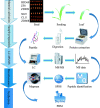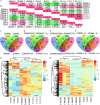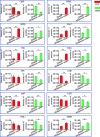Comparative proteomic analysis reveals that the Heterosis of two maize hybrids is related to enhancement of stress response and photosynthesis respectively
- PMID: 33422018
- PMCID: PMC7796551
- DOI: 10.1186/s12870-020-02806-5
Comparative proteomic analysis reveals that the Heterosis of two maize hybrids is related to enhancement of stress response and photosynthesis respectively
Abstract
Background: Heterosis refers to superior traits exhibiting in a hybrid when compared with both parents. Generally, the hybridization between parents can change the expression pattern of some proteins such as non-additive proteins (NAPs) which might lead to heterosis. 'Zhongdan808' (ZD808) and 'Zhongdan909' (ZD909) are excellent maize hybrids in China, however, the heterosis mechanism of them are not clear. Proteomics has been wildly used in many filed, and comparative proteomic analysis of hybrid and its parents is helpful for understanding the mechanism of heterosis in the two maize hybrids.
Results: Over 2000 protein groups were quantitatively identified from second seedling leaves of two hybrids and their parents by label-free quantification. Statistical analysis of total identified proteins, differentially accumulated proteins (DAPs) and NAPs of the two hybrids revealed that both of them were more similar to their female parents. In addition, most of DAPs were up-regulated and most of NAPs were high parent abundance or above-high parent abundance in ZD808, while in ZD909, most of DAPs were down-regulated and most of NAPs were low parent abundance or below-low parent abundance. Pathway enrichment analysis showed that more of stress response-related NAPs in ZD808 were high parent abundance or above-high parent abundance, and most of PS related NAPs in ZD909 were high parent abundance or above-high parent abundance. Finally, four stress response-related proteins and eight proteins related to PS were verified by PRM, ten of them had significant differences between hybrid and midparent value.
Conclusions: Even though every one of the two hybrids were more similar to its female parent at proteome level, the biological basis of heterosis is different in the two maize hybrids. In comparison with their parents, the excellent agronomic traits of hybrid ZD808 is mainly correlated with the high expression levels of some proteins related to stress responses and metabolic functions, while traits of ZD909 is mainly correlated with high expressed proteins related to photosynthesis. Our proteomics results support previous physiological and morphological research and have provided useful information in understanding the reason of valuable agronomic traits.
Keywords: Heterosis; Maize; Non-additive protein; Proteomic analysis.
Conflict of interest statement
We declare that all authors have no competing interests
Figures






Similar articles
-
Plant height heterosis is quantitatively associated with expression levels of plastid ribosomal proteins.Proc Natl Acad Sci U S A. 2021 Nov 23;118(47):e2109332118. doi: 10.1073/pnas.2109332118. Proc Natl Acad Sci U S A. 2021. PMID: 34782463 Free PMC article.
-
Gene expression analyses in maize inbreds and hybrids with varying levels of heterosis.BMC Plant Biol. 2008 Apr 10;8:33. doi: 10.1186/1471-2229-8-33. BMC Plant Biol. 2008. PMID: 18402703 Free PMC article.
-
Quantitative Proteomics of Zea mays Hybrids Exhibiting Different Levels of Heterosis.J Proteome Res. 2016 Aug 5;15(8):2445-54. doi: 10.1021/acs.jproteome.5b01120. Epub 2016 Jun 29. J Proteome Res. 2016. PMID: 27297264
-
Epigenetic Changes in Hybrids.Plant Physiol. 2015 Aug;168(4):1197-205. doi: 10.1104/pp.15.00231. Epub 2015 May 22. Plant Physiol. 2015. PMID: 26002907 Free PMC article. Review.
-
Molecular dissection of heterosis in cereal roots and their rhizosphere.Theor Appl Genet. 2023 Jul 20;136(8):173. doi: 10.1007/s00122-023-04419-6. Theor Appl Genet. 2023. PMID: 37474870 Free PMC article. Review.
Cited by
-
Advances in Research on the Mechanism of Heterosis in Plants.Front Plant Sci. 2021 Sep 27;12:745726. doi: 10.3389/fpls.2021.745726. eCollection 2021. Front Plant Sci. 2021. PMID: 34646291 Free PMC article. Review.
-
Neuroprotective effect of Astragali Radix on cerebral infarction based on proteomics.Front Pharmacol. 2023 Jun 9;14:1162134. doi: 10.3389/fphar.2023.1162134. eCollection 2023. Front Pharmacol. 2023. PMID: 37361203 Free PMC article.
-
Tandem mass tag (TMT)-based quantitative proteomics analysis reveals the different responses of contrasting alfalfa varieties to drought stress.BMC Genomics. 2024 Aug 27;25(1):806. doi: 10.1186/s12864-024-10702-7. BMC Genomics. 2024. PMID: 39192174 Free PMC article.
-
Non-Additive Gene Expression in Carbon and Nitrogen Metabolism Drives Growth Heterosis in Populus deltoides.Plant Cell Environ. 2025 May;48(5):3529-3543. doi: 10.1111/pce.15371. Epub 2025 Jan 9. Plant Cell Environ. 2025. PMID: 39789702 Free PMC article.
-
Evaluation of Salt-Tolerant Germplasms and Identification of Salt Tolerance-Related Proteins in Upland Cotton at the Seedling Stage.Int J Mol Sci. 2025 Feb 25;26(5):1982. doi: 10.3390/ijms26051982. Int J Mol Sci. 2025. PMID: 40076608 Free PMC article.
References
Publication types
MeSH terms
Grants and funding
LinkOut - more resources
Full Text Sources
Other Literature Sources

